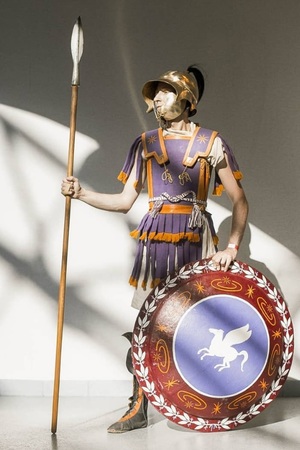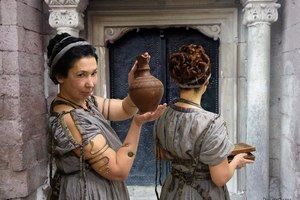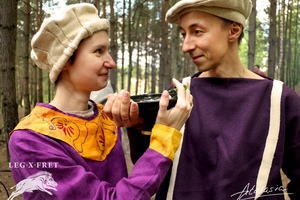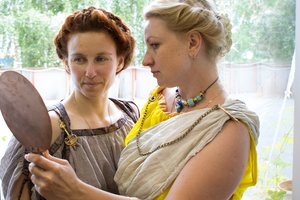Ancient Greece - literature
This section is dedicated to useful literary materials related to the topic of "Ancient Greece".
Main reenactment images of the direction:
Recommended literature on the subject
In Russian:
Armies of Ancient Greece 6-4b dne-Lavrenov. pdf
This book is dedicated to the history, organization, armament, tactics, and traditions of Greek armies from the 6th to the 4th centuries BC. The edition includes color illustrations reflecting the features of the weapons and clothing of warriors during the peak of ancient Greece's power. It is addressed to a wide range of readers.
Greek Hoplite 480-323 dne-NS83. pdf
War is not the first thing that comes to mind when thinking about Ancient Greece. Sculpture, philosophy, drama—these are the things for which the ancient Greeks are primarily famous. Nevertheless, war was a constant factor that the Greeks had to consider in all areas of their activities: political, cultural, or intellectual. War was the subject of most surviving Greek comedies and tragedies, and warriors and military actions were a constant theme in Greek visual arts. A significant portion of classical Greek philosophy is dedicated to the role of the hoplite—the citizen-soldier.
Campaigns of Alexander the Great 334-323 dne-NS188. pdf
To understand the role played by Alexander the Great in history, it is necessary to briefly review the events that determined Greece's relations with Persia over the previous century and a half. The Greek cities on the Asian coast of the Aegean Sea were subject to the Lydian king in Sardis until Lydia was rapidly swallowed up by the expanding Persian Empire. Like the Lydians, the Persians were generally lenient rulers, and the Greeks in the conquered cities did not experience excessive oppression. However, in 499 BC, a rebellion broke out in the Lydian cities. The rebels received assistance from mainland Greek cities, after which Persian kings Darius and Xerxes carried out two unsuccessful punitive expeditions against Greece in 490 and 480 BC. The Persian invasions were repelled, and Greece defended its independence. However, Greek cities soon became embroiled in mutual hostility, and the long-lasting Peloponnesian War between Sparta and Athens (431-404 BC), with its temporary alliances that formed and dissolved, thoroughly exhausted Greece. If the Persians were unable to take advantage of Greek weakness, it was only because after the death of Xerxes in 464 BC, Persia itself entered a period of intrigue and internal conflicts. Xerxes was succeeded by Artaxerxes I, who showed considerable diplomatic skills, but in 404 BC, Persia lost control of Egypt, and it was only in 343 BC that Artaxerxes III managed to bring this province back into the Persian Empire with the help of the Greek mercenary commander Mentor. During the years of the Peloponnesian War, Persian satraps (provincial governors) in Asia Minor, sometimes acting together, sometimes independently, supported either Athens or Sparta, thus weakening both rivals in their endless and futile war. For example, Athens' defeat in 404 BC occurred because the Spartan admiral Lysander received a substantial sum from the Persians for the construction and outfitting of his fleet...
Sex life in Ancient Greece. pdf
A fundamental study of Greek sensibility based on ancient sources. The book provides detailed coverage of topics such as eroticism in Greek literature, eroticism and Greek religion, Greek homosexuality, and much more. Published in the late 1920s, Lichte's monograph has seen multiple reprints, has been translated into several languages, and has not lost its relevance. The book is of interest to specialists (classical philologists, historians of ancient culture, philosophers) as well as to a wide range of readers.
In foreign languages:
Greece and Rome at war - Connolly Peter.pdf
In this luxurious guide to twelve centuries of military development, Peter Connolly combines detailed descriptions of the weaponry and armies of Greece and Rome with his superb full-color works of art. Using fresh archaeological evidence and new material on the production and use of weapons from that period, the author presents an attractive and impressive volume, which is both scholarly and beautifully illustrated. These illustrations, which are rightly recognized as the best and most accurate representation of the soldiers from these formidable military empires, vividly demonstrate the face of battle in the ancient world. Covering the wars between the Greeks and Persians and the epic struggle between the Romans and their most capable opponent, Hannibal, as well as organization, tactics, armor, weapons, and much more, this outstanding work brings the armies of Greece, Macedonia, and Rome to life. This revised edition includes a Foreword by Adrian Goldsworthy.

 Gallery
Gallery













